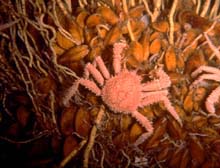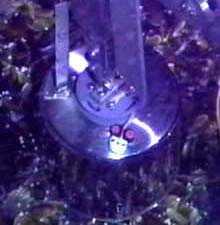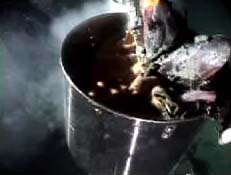
Spider crabs and other deep-sea animals visit chemosynthetic communities, such as this mussel bed in the Gulf of Mexico, to feed on smaller creatures. We hope to encounter such sights during our exploration of Blake Ridge. Photo by C. Fisher. Click image for larger view.
The Deep East Odyssey Continues
September 22, 2001
Paula Keener-Chavis, Director
South Carolina Statewide Systemic Initiative’s Charleston Math and Science Hub
Deep East Education Project Coordinator
Many the wonders I this day have seen. The ocean with its vastness, its blue green, its ships, its rocks, its caves, its hopes, its fear, its voice mysterious, which who’so hears must think on what will be, and what has been.--John Keats
![]() Watch a video clip of a Van Dover mussel pot being deployed.
Watch a video clip of a Van Dover mussel pot being deployed.
![]() Watch a video of a Van Dover Mussel Pot retreiving a benthic invertebrates sample from a deep sea mussel bed community.
Watch a video of a Van Dover Mussel Pot retreiving a benthic invertebrates sample from a deep sea mussel bed community.
Dr. Cindy Lee Van Dover, a professor of biology at the College of William and Mary and chief scientist of Leg 3 of the Deep East 2001 Voyage of Discovery, opened our first science meeting with the following question, and a challenge: "Who knows what microhabitats are out there? That's a big part of what makes this expedition such an adventure. I encourage everyone here to think about how we can best do our work in order to ask the questions that will drive future investigations of this area."
Joining her are Dr. Joan Bernhard, professor of environmental health

![]() Van Dover mussel pots are designed to sample mussel beds and the associated community. Click on this image to see a video clip of a Van Dover mussel pot being deployed.
Van Dover mussel pots are designed to sample mussel beds and the associated community. Click on this image to see a video clip of a Van Dover mussel pot being deployed.
sciences at the University of South Carolina; Dr. Carolyn Ruppel, associate professor of earth and atmospheric sciences at Georgia Technical University, and coordinator of the university's focused research program on gas hydrates; Dr. Barun Sen Gupta, the Henry V. Howe professor of geology at Louisiana State University; and Dr. Paul Aharon, Loper Chair in environmental geology at the University of Alabama. Mr. Andrew Shepard, Deep East Expedition coordinator and associate director of the National Undersea Research Center at the University of North Carolina at Wilmington; Mr. Joe Wargo, a program analyst for NOAA’s Office of Ocean Exploration; and a host of graduate students are also on the science team for Leg 3, the final leg of Deep East. We will explore Blake Ridge, a thick sequence of sediments (sediment drift) deposited where deep-ocean currents intersect, some 2,100-2,800 m off the southeast U.S. coast from South Carolina to northern Florida. Blake Ridge is an important gas- hydrate province, because it is one of the places where gas hydrates were first collected, and they underlie a large portion of the area.

![]() Click the image above to see a Van Dover Mussel Pot retreive a sample of benthic invertebrates from a deep sea mussel bed community.
Click the image above to see a Van Dover Mussel Pot retreive a sample of benthic invertebrates from a deep sea mussel bed community.
The first meeting of the science team, held in the library of the research vessel (R/V) Atlantis, laid the groundwork for sampling protocols. Discussions proceeded about how to most effectively load collecting gear into the Alvin manned submersible's basket (a 4' x 3' flat platform mounted on the lower bow). The team decided that the sample collection strategy will be repeated on each of the five dives plannned for the coming week. Mussels, if they are found, will be collected using Van Dover mussel pots, a unique device engineered by our chief scientist. The pot itself looks like a large Dutch oven turned upside-down with a canvas bag inside. The mussel pots will be lowered over a mussel bed, and Alvin's manipulator arm will rotate a take-up spool to close the bag with a drawstring, collecting mussels and other organisms living among them.
Push cores, which are large, hollow cylinders that open on one end, will be gently pushed by Alvin’s manipulator arm into the sediment to collect sediment samples, and a container of shells will be placed in a strategic location and left for a period of time to observe recruitment/colonization rates. Any other interesting items, including other organisms and rocks, will be loaded into "bioboxes" and milk crates strapped on Alvin’s basket. Once the samples reach the surface, scientists and graduate students will work quickly to retrieve them for preservation. Samples will then undergo preliminary observations in the shipboard labs prior to more intensive analyses back on shore.
The scientists are also interested in comparing deep-sea mussels beds and those found in shallow waters along the U.S. coast. They will also collect single-celled foraminiferans and baseline subsea-floor hydrogeologic data to test a new set of hypotheses that relate to the amount, composition, and distribution of gas produced by bacteria found in sea-floor sediments.
"No one has ever brought Alvin here before, and it will be interesting to compare this area to similar seep communities in the Gulf of Mexico," Dr. Van Dover noted. "My group is after the biogeography." She then closed with another question: "What we want to know is, 'How unique is this community as compared to other chemosynthetic communities found in other parts of the deep sea?' "

Katie Knick, graduate student at Virginia's College of William and Mary, checks mussel pots loaded into Alvin’s basket. Click image for larger view.
Interview with Katie Knick
First-year Graduate Student
Biology Program
The College of William and Mary
Ocean Explorer Team: What are your responsibilities on the Deep East Expedition?
Katie Knick: The Blake Ridge is the site of my master’s thesis research. I'm interested in studying the biodiversity of mussel beds. I plan to describe the species composition and community structure of the organisms living in these beds. I will compare my findings at Blake Ridge to other seep sites, such as the Florida Escarpment and Barbados Prism, and hydrothermal vent sites along the Mid-Atlantic Ridge and Eastern Pacific Rise. On the ship, I am responsible for video logging of the samples from Alvin, making sure the cruise notebook is up to date, and preserving mussel samples.
Ocean Explorer Team: As a first-yr graduate student, what is your perspective on the expedition?
Katie Knick: This is my second cruise on the R/V Atlantis, but it's the first time I’ll dive at a site that has never been explored from a biological perspective. No one knows what types of organisms we’ll bring up from the seep site. I find this fascinating! That’s why I chose Blake Ridge as my research site. This cruise is an excellent opportunity to underline the importance of ocean exploration, and to continue our efforts for explore what is truly Earth's final frontier.
Ocean Explorer Team: What and/or who influenced your decision to study ocean sciences?
Katie Knick:I’ve always been fascinated by nature. As a child, I loved hiking in the Blue Ridge Mountains of Virginia and taking walks on the beaches of Charleston, SC. I’ve always known that I wanted a career working with animals, and for a long time, I thought I would pursue a degree in veterinary medicine. After studying wildlife in Kenya, I quickly changed my mind. I realized I wanted a career in field biology, so I looked into graduate programs. I came across the research of my advisor, Dr. Cindy Lee Van Dover, and found it intriguing. I mean, how many people get to dive to the bottom of the ocean?
Ocean Explorer Team: What do you hope to do when you finish graduate school?
Katie Knick:When I finish my master’s degree I plan to pursue a career in field biology. I’m not exactly sure where my career path will take me, but I do know that ecology will be my focus -- whether on land or at sea.
Sign up for the Ocean Explorer E-mail Update List.
































